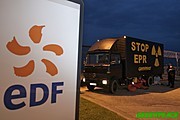26.04.2007 Lauri Myllyvirta  Flamanville (France), 26 April 2007 – On the anniversary of the Chernobyl disaster, 30 Greenpeace activists from six European nations have halted construction at the site of EDF’s proposed new European Pressurized Water Reactor (EPR). Protestors warned of increased nuclear contamination risks across Europe, should this new generation of reactors be adopted. Flamanville (France), 26 April 2007 – On the anniversary of the Chernobyl disaster, 30 Greenpeace activists from six European nations have halted construction at the site of EDF’s proposed new European Pressurized Water Reactor (EPR). Protestors warned of increased nuclear contamination risks across Europe, should this new generation of reactors be adopted.
Activists blocked the entrance to the site with trucks and occupied cranes and other construction equipment, demanding an immediate halt to construction at both Flamanville in France and Europe’s other EPR site at Olkiluoto, Finland, calling the plants dangerous, unnecessary and uneconomic.
“We’re occupying the construction site to highlight the risk to all of Europe and we call upon the two candidates for France’s presidential election to cancel the EPR project at Flamanville. The proposed construction of such new reactors, which are likely to be the most dangerous in the world, is an insult to the memory of those who died in the immediate aftermath of Chernobyl,
and the hundreds of thousands of people whose lives continued to be blighted by the disaster.” said Frederic Marillier of Greenpeace France. “The proposed construction of the reactors at Flamanville and at Olkiluoto, in Finland is based on lies and misrepresentations. These reactors are not failsafe, they are not financially viable and they are not a solution to global warming.”
A recent independent study has shown that the new generation of EPR reactors have an inherently higher risk of serious radioactive contamination in the event of any accident. The study by John Large Associates (1) projects that for the reactor proposed for Flamanville in Normandy which is fuelled by MOX (reactor grade plutonium) as opposed to the current Low Enriched Uranium, the number of people affected and requiring evacuation following the most likely of nuclear incidents would increase from about 230,000 to about 660,000. In a worst case scenario, the number of people evacuated would increase to more than 3 million.
Aside from the safety issues, the development of new reactors cannot be justified on economic or environmental grounds. The EPR being constructed at Olkiluoto in Finland has been beset by problems with design and construction.
“Like most reactors built in the last 30 years, the proposed new EPR in Finland is 18 months behind schedule, over 700 million euros over-budget, and already has more than 700 identified safety issues” Greenpeace Nordic Energy Campaigner Lauri Myllyvirta said.
The only solutions to global warming are those outlined in Greenpeace’s ‘Energy [R]evolution’, a global blueprint for how the world can use a combination of renewable sources of energy and energy efficiency measures to provide for the expected growth in demand, whilst phasing out nuclear power. As the report points out, it is physically impossible for nuclear power to make any impact on future demand anyway, because of the huge financial resources required and the
time required to construct new reactors, even under the most optimistic plans.
For example, according to a U.S. Council on Foreign Relations report released April 18, the US now has 103 operating power reactors and even with 20-year extensions of their planned lifespan, all existing reactors will likely have to be decommissioned by 2050 and a new reactor would have to be built every four to five months for the next 40 years just to replace the existing plants.
“Every euro spent on futile and dangerous nuclear technology in a misguided attempt to reduce greenhouse gas emissions is taking us a step away from the real solution to climate change.” concluded Marillier.
Notes to Editor:
(1) The EPR targets to attain much higher levels of LEU fuel irradiation
(burn-up) than hitherto achieved in commercial PWR power generation. Higher
fuel burn-up not only increases the quantity of fission products available for
release, and hence a greater potential radiological impact, but it introduces
uncertainty over the amount of radioactivity released from the individual fuel
pellets and pins in a reactor core degrade or melt down. Recent research
programmes have shown a significant increase in release fractions for both LEU
and MOX fuels at higher levels of burn-up so, in this respect, the release
fractions assumed for this analysis may result in an under-assessment of both
the LEU and, particularly, MOX fuel cases. (Large Report for Greenpeace)
For further information please contact:
Chris Harris, Greenpeace International EPR Coordinator: +33 6 98 25 38 38
Frederic Marillier, Greenpeace France Energy Campaigner: +33 6 73 89 55 05
Lauri Myllyvirta, Greenpeace Nordic Energy Campaigner, +358 50 3625 981
Adelaide Colin, Greenpeace International Comms Officer: +33 6 84 25 08 25
Images and video are available:
Hester van Meurs, Greenpeace International Video Production: +31 20 718 2090
Franca Michienzi, Greenpeace International Picture Desk: +31 653 819 255 |















